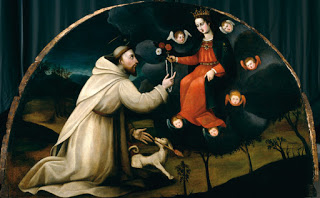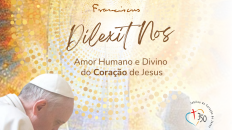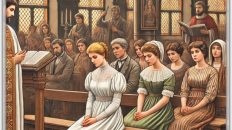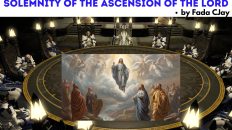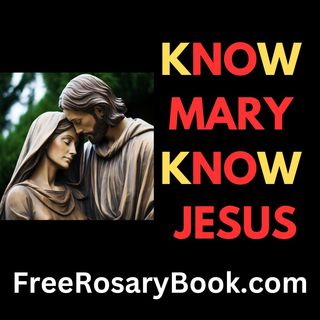EXPLAINED IN THE SCRIPTURE AND THE CHURCH’S TRADITION
it in the Bible? Please show me where we can find this prayer in the Bible? You
people don’t pray well…” These and many others are the usual questions that
come from the opposing Protestants whenever they see a Catholic reciting the
prayers of the Rosary or putting on the sacramental. In this light, this post
is aimed at enlightening the minds of those who question this prayer called the
Holy Rosary and show with Biblical proofs, the authenticity of this prayer.
pleases me today, to bring up the topic of the Holy Rosary as we celebrate the
feast of St. Dominic Guzman. As many of us know, the form of the Rosary as we
have today came to us through this Holy founder of the Order of preachers
(Dominicans). Put differently, St. Dominic received the Holy Rosary from the
Blessed Virgin Mary in an apparition in 1214. Be that as it may, it is
pertinent to make clear that the Holy Rosary has been in existence even before
the time of St. Dominic, but in its crude form.
roses”, the rose being one of the flowers used to symbolize the Virgin Mary. Some
Protestants now say the rosary, recognizing it as a truly biblical form of
prayer—after all, the prayers that comprise it come mainly from the Bible. The
origin of the Holy Rosary is actually complex, dating itself to the times of
the early Christians. Also, the practice of counting prayers dates itself to
the Old Testament times. Originally the rosary had 150 beads, the same number
of psalms in the Bible. In those days, religious orders recited together the
150 Psalms as a way to mark the hours of the day and the days of the week.
Those people who didn’t know how to read wanted to share in this practice, so
praying on a string of 150 beads or knots began as a parallel to praying the
psalms as a way that they could remember the Lord and his Mother throughout the
day, by reciting the Lord’s Prayer and the hail Mary… The “Divine Office”;
the official prayer of the church; is the recitation of the psalms and
canticles over a four week period, and is still prayed today.
asked to pray the Lord’s Prayer and the Hail Mary in substitute for the psalms,
since they cannot read and write; why can’t other forms of prayers be used? It
is apposite to note that there exists an intrinsic relationship between the
Psalms and the New Testament (Gospels). Put differently, the Psalms gives an
allusion to the life of Christ in the New Testament; in the same vein, the Holy
Rosary is seen as the summary of the life of our Lord Jesus Christ in his
Redemptive work, and the cooperation of his Blessed Mother in its realization.
It was in this light that we come about the origin of praying and counting on
beads (the rosary in its crude form) which came to serve as a substitute for
the psalms especially for those who cannot recite the liturgy of the hours
(Divine Office)
pass their fingers over each bead and say a prayer, usually the “Our Father”.
The “Hail Mary” prayer came later. Then people said the “Hail
Mary” in the twelfth century, that is, “Angel Gabriel’s
Greeting”. Hence, “Hail Mary, full of grace, the Lord is with thee” was
often said along with the Our Father. Later, Elizabeth’s greeting: “blessed are
you among women” was added. It was not until the sixteenth century that the
words “Holy Mary, Mother of God, pray for us sinners now and at the hour of our
death” were added.
the centuries. In the fifteenth century, a Carthusian monk divided the rosary
into fifteen brackets (or decades) and a Dominican assigned mysteries to each
of the decades. These mysteries were events in the life of Jesus as written in
the gospels, and understood to the illiterates.
1917 was to encourage devotion to Her Immaculate heart, daily recitation of the
Holy Rosary and to make reparation for sins.
the following year would be the “Year of the Rosary”. For the first time in
centuries a change was made in the rosary. The Pope added and defined 5 new
mysteries that concerned events in the public life of Jesus. These new
mysteries were called the “Luminous Mysteries” or “Mysteries of Light” Today’s
complete rosary is now made up of twenty decades of the Hail Mary, separated by
an Our Father and a “Glory Be…” and sometimes the Fatima prayer.
of the rosary has always remained the same. It is a way for God’s people to
make holy the day, and to remember the life of Jesus and his mother.
each time we pray the rosary.
the Holy Rosary as explained from the Scripture and Tradition.
The Mysteries
disciples asked him to teach them to pray (Luke 11:1-13)
Lord is with thee.” This is nothing other than the greeting the angel
Gabriel gave Mary in Luke 1:28. The next part reads this way:
“Blessed art thou among women, and blessed is the fruit of thy womb,
Jesus.” This was exactly what Mary’s cousin Elizabeth said to her in Luke
1:42. The only thing that has been added to these two verses are the names
“Jesus” and “Mary,” to make clear who is being referred to.
So the first part of the Hail Mary is entirely biblical. The second part of the
Hail Mary is not taken straight from Scripture, but it is also biblical in the
thoughts it expresses. It reads:
and at the hour of our death. Amen.”
to saying “Holy Mary” because they claim Mary was a sinner like the
rest of us. But Mary was a Christian (the first Christian, actually, the first
to accept Jesus; cf. Luke 1:45), and the Bible describes Christians in general
as holy. In fact, they are called saints, which mean “holy ones”
(Eph. 1:1, Phil. 1:1, Col. 1:2). Furthermore, as the mother of Jesus Christ,
the Incarnate Word of God, Mary was certainly a very holy woman. (she even said
all generations would call her blessed Lk. 1:48)
called the “Gloria Patri”. In English, it reads: “Glory be to the Father, and to
the Son, and to the Holy Spirit. As it was in the beginning, is now, and ever
shall be, world without end. Amen.”
I hereby say that the title doesn’t mean Mary is older than God; it means the
Person who was born of her is both Human and Divine. The denial that Mary had
God in her womb is a heresy known as Nestorianism (which claims that Jesus was
2 different persons, one Human and another Divine), and that the Virgin Mary gave birth to only the
human Jesus. This is entirely WRONG! The Bible makes us to understand that Mary
was conceived by the Holy Spirit and gave birth to Jesus who is God (see.
Isaiah 9:6 “For to
us a child is born, to us a son is given, and the government will be on his shoulders.
And he will be called Wonderful Counselor, Mighty God, Everlasting Father,
Prince of Peace.”) Little wonder the shepherds came and adored the new
born King (see Luke 2)
the last: “pray for us sinners now and at the hour of our death.”
Many non-Catholics think such a request denies the teaching of 1Timothy 2:5:
“For there is one God, and there is one mediator between God and men, the
man Christ Jesus.” But in the preceding four verses (1 Tim. 2:1-4), Paul
instructs Christians to pray for each other, meaning it cannot interfere with
Christ’s mediatorship: “I urge that prayers, supplications, petitions, and
thanksgivings be made for everyone… This is good, and pleasing to God our Saviour.” We know this exhortation to pray for
others applies to the saints in heaven who, as Revelation 5:8 reveals,
intercede for us by offering our prayers to God: “The twenty-four elders
fell down before the Lamb, each holding a harp, and with golden bowls full of
incense, which are the prayers of the saints”
Joyful Mysteries:
1. The Annunciation (Humility) Luke 1: 26-38; John 1:14
2. The Visitation (Charity/Love of Neighbor) Luke 1: 39-56
3. The Nativity (Poverty) Luke 2: 6-20; Matthew 1:18-25
4. The Presentation (Obedience) Luke 2: 22-39
5. The Finding of the Child Jesus in the Temple (Joy in finding Jesus;
prudence) Luke 2: 41-51
Luminous Mysteries:
1. The Baptism of Jesus (Fidelity to our baptismal promises) Matthew 3:11-17;
Luke 3:15-22; John 1:22-34
2. The Wedding Feast at Cana (Faith in Mary‘s intercession and maternal care)
John 2: 1-12
3. The Proclamation of the Kingdom (Conversion of heart) Mark 1:14-15; Matthew
5:1-8; Matthew 6:33; Matthew 7:21
4. The Transfiguration (Become a new person in Christ) Luke 9:28-36; Matthew
17:1-8
5. The Institution of the Eucharist (Love of the Eucharist; active
participation at Mass); Matthew 26:26-28; John 6: 33-59
*Note:
The five Luminous Mysteries, or Mysteries of Light, were introduced in 2002 by
Pope John Paul II in Rosary of the Virgin Mary.
Sorrowful Mysteries:
1. The Agony in the Garden (True sorrow for sin; repentance) Matthew 26: 36-46;
Mark 14:32-42; Luke 22: 39-46
2. The Scourging at the Pillar (Modesty and purity; mortification or
self-denial) Matthew 27:26; Mark 15:15; John 19:1
3. The Crowning of Thorns (Moral courage; love of our enemies) Matthew
27:29-30;
Mark 15:16-20; John 1: 2-3
4. The Carrying of the Cross (Patience, especially when suffering; fortitude)
Luke 23: 26-32; Matthew 27:31-32; Mark 15:21; Luke 23: 26-32
5. The Crucifixion (Perseverance; mercy) Luke 23: 33-46; Matthew 27: 33-54;
Mark 15: 22-39; Luke 23: 33-47; John 19: 17-37
1. The Resurrection (Faith) Matthew 28: 1-10; Mark 16: 1-18; Luke 24: 1-49;
John 20:1-29
2. The Ascension (Hope) Mark: 16: 19-20; Luke 24: 50-51; Acts 1: 6-11
3. The Descent of the Holy Spirit (Love of God; gifts of the Holy Spirit)
Acts 2: 1-41
4. The Assumption* (Grace of a happy death; eternal happiness)
Revelation 12:1
5. Crowning of Mary as Queen of Heaven and Earth* (True devotion to Mary)
Revelation 12:1
*
Mary‘s Assumption and Coronation are implied in Revelation Chapter 12 and in
other Biblical references, but neither is directly stated in the Bible. Both
events are part of Catholic Tradition. The Catechism of the Catholic Church
defines the Assumption in Sections 966 and 974.
pray you Lord, that while praying the rosary, we may imitate what they contain
and obtain what they promise, through the intercession of St. Dominic whose feast
we celebrate today. Amen!
